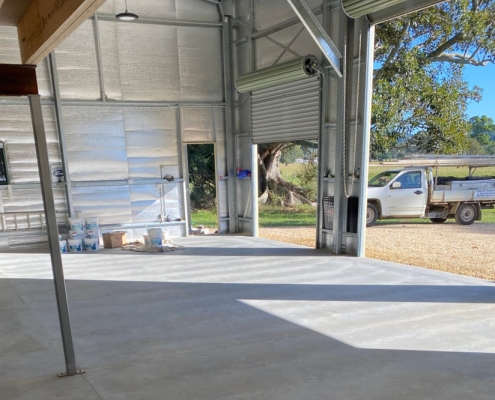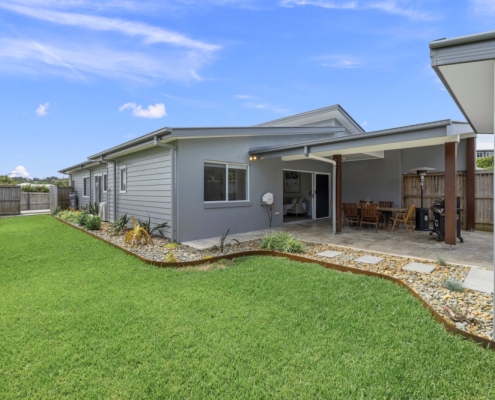Interior vs. Exterior Painting: Key Differences and What You Should Know
When it comes to painting, not all jobs are created equal. Interior and exterior painting may both involve adding colour and protection to surfaces, but each type requires different products, techniques, and considerations. Understanding these differences will help you choose the right products and approaches for your specific needs. In this guide, we’ll explore the key distinctions between interior and exterior painting and provide tips to ensure the best results for your project.
Purpose of Interior and Exterior Painting
Interior Painting
The primary purpose of interior painting is to improve aesthetics and create a comfortable, attractive living environment. Interior paints are chosen to complement the home’s décor, protect walls from daily wear and tear, and, in some cases, improve air quality with low or zero-VOC options.
Exterior Painting
Exterior painting, on the other hand, is mainly about protection. Exterior paint shields the building from harsh weather, moisture, and UV damage, extending the life of the structure. While aesthetics are also important, durability and resilience are the primary considerations for exterior paint.
Key Differences Between Interior and Exterior Paints
1. Composition and Durability
Interior Paints: Designed to withstand scrubbing, cleaning, and minor impact without fading or chipping, interior paints prioritise smooth finishes and colour retention. They contain additives that make them more resistant to scuffing and staining, perfect for spaces where cleaning may be necessary.
Exterior Paints: Exterior paints are formulated with more durable resins and binders to withstand the elements. They’re water-resistant, fade-resistant, and can handle temperature fluctuations. Many exterior paints also contain mildew and mould inhibitors to prevent growth in damp conditions.
2. VOC Levels
Interior Paints: Volatile Organic Compounds (VOCs) are a concern for indoor spaces because they can impact air quality. Low-VOC or zero-VOC options are commonly used for interiors to minimise odours and reduce health risks, making them suitable for bedrooms, living rooms, and other frequented areas.
Exterior Paints: Because exterior paints are applied outdoors, they can contain higher VOC levels. This allows manufacturers to incorporate additives for increased durability and weather resistance without posing a health risk indoors.
3. Finishes
Interior Paint Finishes: Interior paints are available in various finishes, such as matte, satin, semi-gloss, and high gloss. Matte and satin finishes are popular for walls, while semi-gloss and high gloss are often used on trim, doors, and mouldings. These finishes are chosen based on the aesthetic effect and the room’s function, with higher gloss levels providing better stain resistance in high-traffic areas.
Exterior Paint Finishes: Exterior paints typically come in flat/matte, satin, and semi-gloss finishes. Matte is often used on large wall areas, while satin and semi-gloss finishes add shine and protect trim, doors, and other architectural details. Gloss levels for exterior paints are generally lower than for interior, as high gloss can be too reflective in sunlight.
4. Drying Time
Interior Paints: Interior paints usually dry faster, allowing for quicker recoating. This is convenient for enclosed spaces where people want to resume regular activities as soon as possible.
Exterior Paints: Exterior paints take longer to dry, which is necessary for better bonding in outdoor conditions. Factors like humidity, temperature, and wind also impact drying time, so exterior painting is best done in suitable weather.
Differences in Application Techniques
1. Preparation
Interior Painting Preparation: Interior painting requires careful protection of furniture, flooring, and other surfaces. Prep work often involves cleaning walls, patching small holes, and priming if necessary. Masking tape is used to protect trims and create clean lines.
Exterior Painting Preparation: Exterior surfaces tend to have more dirt, peeling paint, and potential for mildew, requiring pressure washing and scraping. Priming is essential for exterior paint to adhere correctly, especially on surfaces exposed to weather and wear.
2. Tools and Equipment
Interior Painting Tools: For interior painting, rollers, brushes, and drop cloths are commonly used. Spray painting is possible for larger spaces but requires more prep to avoid overspray indoors.
Exterior Painting Tools: Exterior painting often involves ladders, scaffolding, and pressure washers. Larger surfaces and textured areas may require paint sprayers for an even, fast application, while rollers and brushes are used for detail work.
3. Safety Considerations
Interior Painting Safety: Proper ventilation is essential when painting indoors, even with low-VOC or zero-VOC paints. Masking off areas and using ladders safely in confined spaces are also important.
Exterior Painting Safety: Safety equipment like harnesses, protective eyewear, and gloves are crucial for exterior work, especially for multi-story buildings. Weather conditions should also be monitored to ensure safety during the project.
Factors to Consider When Choosing Paint for Interior vs. Exterior
1. Climate and Weather
For exterior painting, the local climate plays a major role. Coastal homes, for example, need paints that resist salt and moisture, while homes in sunny areas require UV-resistant products. For interiors, consider factors like light exposure and traffic levels in each room when choosing paint finishes and colours.
2. Aesthetics and Design
Interior Paint Aesthetics: Interior paint choices can reflect personal style and create specific moods for each room. From soothing neutrals in bedrooms to bold colours in living rooms, colour choices can have a significant impact on comfort and visual appeal.
Exterior Paint Aesthetics: Exterior paint plays a role in curb appeal and should complement the architectural style of the home and the surrounding environment. Many homeowners opt for neutral colours on walls and use accent colours on trims and doors to add character.
3. Longevity and Maintenance
Interior Paint Maintenance: Most interior paints last 5-10 years, depending on usage and room conditions. High-traffic areas may require touch-ups, and washable finishes can help keep walls clean.
Exterior Paint Maintenance: Exterior paints are designed to last longer, with a lifespan of 7-15 years, but exposure to elements will eventually cause fading or chipping. Regular washing and touch-ups can extend the paint’s life.
Pros and Cons of Interior and Exterior Painting
Interior Painting
Pros:
- Enhances aesthetics and personalises indoor spaces
- Provides protection from scuffing and stains
- Can improve indoor air quality with low-VOC options
Cons:
- Requires more detailed prep and protection for flooring and furniture
- Paint fumes can impact indoor air quality temporarily, even with low-VOC options
Exterior Painting
Pros:
- Adds a protective layer against weather and moisture
- Enhances curb appeal and property value
- Increases longevity of building materials
Cons:
- Dependent on weather conditions, which can delay the project
- More costly and labour-intensive due to required equipment and safety measures
Tips for Successful Interior and Exterior Painting Projects
Tips for Interior Painting
- Choose the Right Paint Finish: Matte and satin finishes work well in low-traffic areas, while semi-gloss and high gloss are ideal for high-traffic or moisture-prone rooms like kitchens and bathrooms.
- Consider Lighting: Natural and artificial light can impact how paint colours appear in a room. Test colours in different lighting before making a final decision.
- Ventilate the Space: Proper ventilation reduces paint fumes and speeds up drying time, especially in enclosed rooms.
Tips for Exterior Painting
- Monitor Weather Conditions: Choose a mild day with low humidity for optimal drying conditions. Avoid painting on rainy, windy, or extremely hot days.
- Prioritise Surface Preparation: Thoroughly clean and prime surfaces for the best results. Pressure washing and patching any damaged areas ensures paint adheres properly.
- Choose High-Quality Exterior Paints: Invest in paints specifically formulated for the local climate. UV-resistant, waterproof, and mildew-resistant paints will protect your home for years to come.
Conclusion: Choosing the Right Approach for Your Painting Project
Interior and exterior painting may seem similar, but the differences in products, preparation, and techniques are significant. Interior painting focuses on aesthetics and durability within a controlled environment, whereas exterior painting prioritises protection from environmental factors.
Understanding these distinctions will help you make informed choices, whether you’re refreshing your living room or giving your home’s exterior a new lease on life. For the best results, consider working with professionals who understand the nuances of both interior and exterior painting to ensure a beautiful, long-lasting finish that adds value to your property.
If you’re ready to start your painting project, contact us for expert guidance and quality painting services tailored to your specific needs. Let’s bring your vision to life, inside and out.








